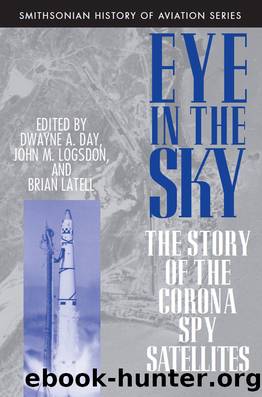Eye in the Sky by Dwayne Day

Author:Dwayne Day [Day Dwayne]
Language: eng
Format: epub
ISBN: 978-1-58834-518-9
Publisher: Smithsonian
Published: 2015-05-25T16:00:00+00:00
A mockup of the Sputnik II payload complete with Soviet dog. When the Soviet Union launched Sputniks I and II, they raised fears of surprise attack among many in the West. But they also unwittingly played into the Eisenhower administration’s hands and established the concept of “freedom of space” for future reconnaissance satellites. (Photo courtesy of the National Reconnaissance Office)
Discussion of the Defense Special Projects Agency continued within the administration. Its name was changed to the Advanced Research Projects Agency (ARPA) and Eisenhower sent a message to Congress on January 7 requesting supplemental appropriations for the agency.41
On February 7, 1958, James Killian and Din Land, who was also a member of the President’s Board of Consultants on Foreign Intelligence Activities, met with Eisenhower and his staff secretary, General Andrew Goodpaster. They briefed the president on the potential of both a recoverable space capsule and a supersonic reconnaissance aircraft program, suggesting that in order to speed up the development of a reconnaissance satellite, the United States should pursue the recoverable capsule idea as an “interim” solution. Eisenhower accepted this recommendation and the satellite program was soon named CORONA.
An equally important result of this first meeting was the decision to finalize Secretary of Defense McElroy’s proposal and create ARPA to house highly technical defense research programs. General Electric executive Roy Johnson was named as its director. Eisenhower decided to give ARPA control of all military space programs, including the military man-in-space program, meteorological programs, and WS-117L.
Sputnik also led to the creation of NASA, a civilian space program. Although Eisenhower initially felt that the military could handle the task of space science, he was eventually persuaded that a civilian space agency was needed, in part by Vice-President Nixon, who argued that a civilian agency was important for international prestige purposes. A military space agency could not be used as an effective means to show the flag, particularly if the president wanted to prevent escalation of the Cold War.
The creation of these new organizations, both civilian and military, proceeded apace, drawing much attention from the Congress and the public. ARPA was officially in charge of the nation’s WS-117L reconnaissance satellite program, whose existence the Air Force had leaked to the press in the aftermath of Sputnik. At the same time, Eisenhower directed that the recoverable satellite program—the program that eventually became known as CORONA—be handled by a covert team involving the Air Force and the CIA. For many who had been involved in it, including those who had proposed it, the recoverable satellite program simply ceased to exist. As far as they knew, WS-117L was the only U.S. reconnaissance satellite program.
Those in charge of WS-117L eventually divided it into several programs, including the SENTRY reconnaissance program (later SAMOS), an early warning satellite known as MIDAS, and Discoverer, an engineering and development program that was to include the launching of biomedical payloads such as mice and monkeys. In reality, Discoverer was nothing more than a cover for the CORONA program, and SENTRY appears to have
Download
This site does not store any files on its server. We only index and link to content provided by other sites. Please contact the content providers to delete copyright contents if any and email us, we'll remove relevant links or contents immediately.
| AI & Machine Learning | Bioinformatics |
| Computer Simulation | Cybernetics |
| Human-Computer Interaction | Information Theory |
| Robotics | Systems Analysis & Design |
Algorithms of the Intelligent Web by Haralambos Marmanis;Dmitry Babenko(7852)
Hadoop in Practice by Alex Holmes(5660)
Jquery UI in Action : Master the concepts Of Jquery UI: A Step By Step Approach by ANMOL GOYAL(5513)
Life 3.0: Being Human in the Age of Artificial Intelligence by Tegmark Max(4507)
Functional Programming in JavaScript by Mantyla Dan(3723)
The Age of Surveillance Capitalism by Shoshana Zuboff(3423)
Big Data Analysis with Python by Ivan Marin(3012)
Blockchain Basics by Daniel Drescher(2891)
The Rosie Effect by Graeme Simsion(2708)
WordPress Plugin Development Cookbook by Yannick Lefebvre(2602)
Hands-On Machine Learning for Algorithmic Trading by Stefan Jansen(2519)
Applied Predictive Modeling by Max Kuhn & Kjell Johnson(2478)
Dawn of the New Everything by Jaron Lanier(2438)
Test-Driven Development with Java by Alan Mellor(2383)
The Art Of Deception by Kevin Mitnick(2298)
Data Augmentation with Python by Duc Haba(2229)
Rapid Viz: A New Method for the Rapid Visualization of Ideas by Kurt Hanks & Larry Belliston(2195)
Human Dynamics Research in Smart and Connected Communities by Shih-Lung Shaw & Daniel Sui(2178)
The Infinite Retina by Robert Scoble Irena Cronin(2178)
